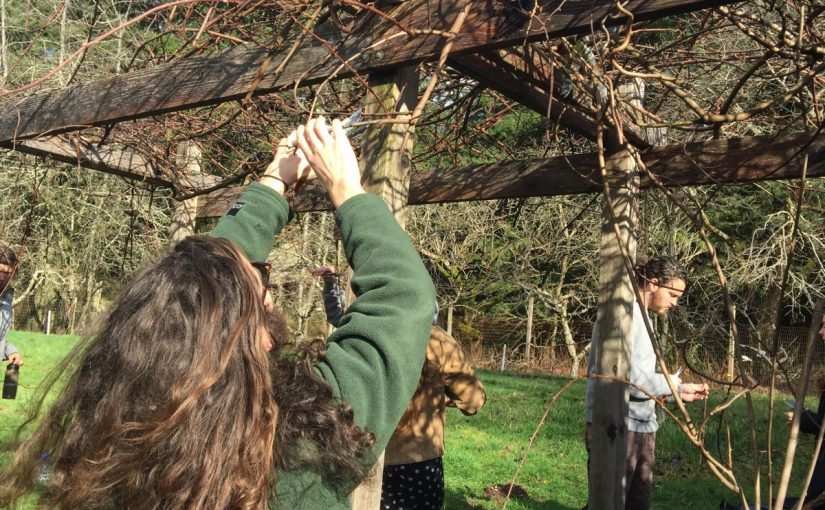Pruning an untamed hardy kiwi plant is quite the endeavor. The kiwis on the organic farm are beyond untamed, and in need of a heavy pruning. Almost all of the canes are tangled and should first all be trimmed down to the edges of the trellis to make for easier work later. The second step is to make sure the leaders of the female plants are spaced 8 to 12 inches apart on the cordon. This will allow for proper light penetration for improved photosynthesis as well as suitable airflow to suppress fungal growth. On the mature females up to 70 percent of the last year’s growth can and should be removed to promote new growth. The canes should be pruned down with a stub left at the base for new growth opportunity. With the level of disorder that currently faces the kiwis, the best thing for the future would be to heavily prune. The trees will produce less next year, however, over time the quality of the fruit will improve, and future pruning will be easier.
Category: Farm Practicum
Pruning Apple Trees
Many considerations should be taken into account to properly maintain a fruit tree. The tree must be a manageable size for easy picking, making the first necessary cuts heading cuts to shorten the height and width. These large cuts must be made in the winter, while the carbohydrates are in the trunk and roots, and the tree is dormant as to not shock the tree. Late winter is ideal for pruning at the eco-dormant state, after the tree has had approximately 1000 hours of chilling time below 45 degrees Fahrenheit. The tip of the central leader must stay to a manageable height and should be cut first. Heading cuts on the lateral branches should also be made at this time to keep the tree in an open bowl shape. Pruning to a Christmas tree like shape is also a popular method, with the top branches shorter in length and the lower branches longer. The cuts should be made at an angle to promote water run off and discourage rot. Cutting of the terminal portion of branch will promote new growth from lower buds. Any dead, severely damaged or diseased wood should be removed in the winter. The maintenance of the scaffold whorl should be taken into account in the winter months, and decisions made whether or not old branches should be removed for healthier new ones to grow. All waterspouts and suckers should be removed at this time. Thinning cuts should also be made in the winter, to remove any overlapping branches that are over a year in age. In the early summer thinning cuts should be made to promote airflow and sunlight penetration. All remaining root suckers and waterspouts, if any, should be removed at this time. Branches should only be removed if at an angle that could not support the weight of fruit or is interfering with a branch that is much more productive than itself. Branches with few reproductive buds might also be removed to give space to those that produce more efficiently. Summer pruning should be finished before the end of July. Pruning is necessary to maintain airflow to keep the tree dry and protect from disease, in addition to sunlight penetration. The quantity of the fruit decreases when a tree is pruned correctly, however, the quality and size of the fruit increases tremendously. Proper pruning techniques allow fruit trees to live much longer and healthier lives. Training from a young age is the best way to make yearly pruning hassle free. If trained to have proper fruit supporting angles from 45 to 60 degrees, the pruning becomes a simple biannual maintenance. If the fruit tree was not initially trained, pruning becomes a difficult and tedious experience.
